Exploring the Role of Ash on Pore Clogging and Hydraulic Properties of Ash-Covered Soils under Laboratory Experiments
Abstract
:1. Introduction
2. Materials and Methods
2.1. Laboratory Rainfall Simulation Experiment
2.1.1. Rainfall Simulator
2.1.2. Soil and Ash Sample Preparation
2.1.3. Experiment Design
2.2. Minidisk Infiltrometer Measurement
2.3. Pore Clogging Measurement
2.3.1. Resin Impregnation
2.3.2. Pore Image Analysis
2.4. Data Analysis
3. Results
3.1. Presence and Severity of Soil Pore Clogging
3.2. Hydraulic Conductivity and Sorptivity
4. Discussion
4.1. The Use of the Resin Impregnation Technique
4.2. Influence of Pore Clogging on Soil Hydrology
5. Conclusions
Author Contributions
Funding
Informed Consent Statement
Data Availability Statement
Acknowledgments
Conflicts of Interest
References
- Balfour, V.N.; Woods, S.W. The hydrological properties and the effects of hydration on vegetative ash from the Northern Rockies, USA. Catena 2013, 111, 9–24. [Google Scholar] [CrossRef]
- Li, Q.; Ahn, S.; Kim, T.; Im, S. Post-fire impacts of vegetation burning on soil properties and water repellency in a pine forest, South Korea. Forests 2021, 12, 708. [Google Scholar] [CrossRef]
- Balfour, V.; Woods, S.W. Does wildfire ash block soil pores? A micromorphological analysis of burned soils. In Proceedings of the AGU Fall Meeting Abstracts, San Francisco, CA, USA, 10–14 December 2007; American Geophysical Union: Washington, DC, USA, 2007. Abstract-Id: H43F-1695. [Google Scholar]
- Fischer, T.; Veste, M.; Wiehe, W.; Lange, P. Water repellency and pore clogging at early successional stages of microbiotic crusts on inland dunes, Brandenburg, NE Germany. Catena 2010, 80, 47–52. [Google Scholar] [CrossRef]
- Neary, D.G.; Klopatek, C.C.; DeBano, L.F.; Ffolliott, P.F. Fire effects on belowground sustainability: A review and synthesis. For. Ecol. Manage. 1999, 122, 51–71. [Google Scholar] [CrossRef]
- Letey, J. Causes and consequences of fire-induced soil water repellency. Hydrol. Process. 2001, 15, 2867–2875. [Google Scholar] [CrossRef]
- DeBano, L.F.; Neary, D.G.; Ffolliott, P.F. Fire Effects on Ecosystems; John Wiley & Sons: Hoboken, NJ, USA, 1998; ISBN 978-0-471-16356-5. [Google Scholar]
- Shakesby, R.A.; Doerr, S.H. Wildfire as a hydrological and geomorphological agent. Earth Sci. Rev. 2006, 74, 269–307. [Google Scholar] [CrossRef]
- Schmidt, R. Descriptive nomenclature and classification of pyroclastic deposits and fragments: Recommendation of the I.U.G.S. subcommission on the systematics of igneous rocks. Geology 1981, 9, 41–43. [Google Scholar] [CrossRef]
- Cerdà, A. The influence of aspect and vegetation on seasonal changes in erosion under rainfall simulation on a clay soil in Spain. Can. J. Soil Sci. 1998, 78, 321–330. [Google Scholar] [CrossRef] [Green Version]
- Henig-Sever, N.; Poliakov, D.; Broza, M. A novel method for estimation of wild fire intensity based on ash pH and soil microarthropod community. Pedobiologia 2001, 45, 98–106. [Google Scholar] [CrossRef]
- Johansen, M.P.; Hakonson, T.E.; Whicker, F.W.; Breshears, D.D. Pulsed redistribution of a contaminant following forest fire: Cesium-137 in runoff. J. Environ. Qual. 2003, 32, 2150–2157. [Google Scholar]
- Bodí, M.B.; Martin, D.A.; Balfour, V.N.; Santín, C.; Doerr, S.H.; Pereira, P.; Cerdà, A.; Mataix-Solera, J. Wildland fire ash: Production, composition and eco-hydro-geomorphic effects. Earth Sci. Rev. 2014, 130, 103–127. [Google Scholar] [CrossRef]
- Mallik, A.U.; Gimingham, C.H.; Rahman, A.A. Ecological effects of heather burning: I. Water infiltration, moisture retention and porosity of surface soil. J. Ecol. 1984, 72, 767–776. [Google Scholar] [CrossRef]
- Balfour, V. The Effects of Forest Fires on Runoff Rates: The Role of Duff Removal and Surface Sealing by Vegetative Ash, Western Montana. Master’s Thesis, The University of Montana, Missoula, MT, USA, 2007. Available online: https://scholarworks.umt.edu/etd/1001/ (accessed on 1 December 2020).
- Woods, S.W.; Balfour, V.N. The effects of soil texture and ash thickness on the post-fire hydrological response from ash-covered soils. J. Hydrol. 2010, 393, 274–286. [Google Scholar] [CrossRef]
- Ebel, B.A.; Moody, J.A. Synthesis of soil-hydraulic properties and infiltration timescales in wildfire-affected soils. Hydrol. Process. 2017, 31, 324–340. [Google Scholar] [CrossRef]
- Stoof, C.R.; Wesseling, J.G.; Ritsema, C.J. Effects of fire and ash on soil water retention. Geoderma 2010, 159, 276–285. [Google Scholar] [CrossRef]
- Stoof, C.R.; Gevaert, A.I.; Baver, C.; Hassanpour, B.; Morales, V.L.; Zhang, W.; Martin, D.; Giri, S.K.; Steenhuis, T.S. Can pore-clogging by ash explain post-fire runoff? Int. J. Wildland Fire 2016, 25, 294–305. [Google Scholar] [CrossRef]
- Woods, S.W.; Balfour, V.N. The effect of ash on runoff and erosion after a severe forest wildfire, Montana, USA. Int. J. Wildland Fire 2008, 17, 535–548. [Google Scholar] [CrossRef]
- Fernández-Raga, M.; Palencia, C.; Keesstra, S.; Jordán, A.; Fraile, R.; Angulo-Martínez, M.; Cerdà, A. Splash erosion: A review with unanswered questions. Earth Sci. Rev. 2017, 171, 463–477. [Google Scholar] [CrossRef] [Green Version]
- Huang, C.H. A Numerical Study of the Raindrop Impact Phenomena. Doctoral Dissertation, Purdue University, West Lafayette, IN, USA, 1982. [Google Scholar]
- Cerdà, A.; Doerr, S.H. The effect of ash and needle cover on surface runoff and erosion in the immediate post-fire period. Catena 2008, 74, 256–263. [Google Scholar] [CrossRef]
- Pereira, P.; Cerdà, A.; Úbeda, X.; Mataix-Solera, J.; Martin, D.; Jordán, A.; Burguet, M. Spatial models for monitoring the spatio-temporal evolution of ashes after fire–a case study of a burnt grassland in Lithuania. Solid Earth 2013, 4, 153–165. [Google Scholar] [CrossRef] [Green Version]
- Pereira, P.; Cerdà, A.; Úbeda, X.; Mataix-Solera, J.; Rein, G. (Eds.) Fire Effects on Soil Properties; Csiro Publishing: Clayton, VIC, Australia, 2019; ISBN 978-036-718-655-5. [Google Scholar]
- Prats, S.A.; Abrantes, J.R.C.D.B.; Coelho, C.D.O.A.; Keizer, J.J.; de Lima, J.L.M.P. Comparing topsoil charcoal, ash, and stone cover effects on the postfire hydrologic and erosive response under laboratory conditions. Land Degrad. Dev. 2018, 29, 2102–2111. [Google Scholar] [CrossRef]
- Vogel, H.J. Morphological determination of pore connectivity as a function of pore size using serial sections. Eur. J. Soil Sci. 1997, 48, 365–377. [Google Scholar] [CrossRef]
- Naveed, M.; Moldrup, P.; Arthur, E.; Wildenschild, D.; Eden, M.; Lamandé, M.; Vogel, H.; de Jonge, L.W. Revealing soil structure and functional macroporosity along a clay gradient using X-ray computed tomography. Soil Sci. Soc. Am. J. 2013, 77, 403–411. [Google Scholar] [CrossRef] [Green Version]
- Peth, C.; Barkusky, F.; Mann, K. Near-edge x-ray absorption fine structure measurements using a laboratory-scale XUV source. J. Phys. D Appl. Phys. 2008, 41, 105202. [Google Scholar] [CrossRef]
- Vogel, H.J.; Weller, U.; Schlüter, S. Quantification of soil structure based on Minkowski functions. Comput. Geosci. 2010, 36, 1236–1245. [Google Scholar] [CrossRef]
- Tuller, M.; Or, D. Hydraulic functions for swelling soils: Pore scale considerations. J. hydrol. 2003, 272, 50–71. [Google Scholar] [CrossRef]
- Vaz, C.M.P.; Tuller, M.; Lasso, P.R.O.; Crestana, S. New perspectives for the application of high-resolution benchtop X-ray microCT for quantifying void, solid and liquid phases in soils. In Application of Soil Physics in Environmental Analyses; Teixeira, W., Ceddia, M., Ottoni, M., Donnagema, G., Eds.; Springer International Publishing AG: Cham, Switzerland, 2014; pp. 261–281. [Google Scholar]
- Tracy, S.R.; Daly, K.R.; Sturrock, C.J.; Crout, N.M.; Mooney, S.J.; Roose, T. Three-dimensional quantification of soil hydraulic properties using X-ray computed tomography and image-based modeling. Water Resour. Res. 2015, 51, 1006–1022. [Google Scholar] [CrossRef] [Green Version]
- Ringrose-Voase, A.J. Measurement of soil macropore geometry by image analysis of sections through impregnated soil. Plant Soil 1996, 183, 27–47. [Google Scholar] [CrossRef]
- Mermut, A.R. Historical development in soil micromorphological imaging. J. Mt. Sci. 2009, 6, 107–112. [Google Scholar] [CrossRef]
- Murphy, C.P. A comparative study of three methods of water removal prior to resin impregnation of two soils. J. Soil Sci. 1982, 33, 719–735. [Google Scholar] [CrossRef]
- Ringrose-Voase, A.J.; Bullock, P. The automatic recognition and measurement of soil pore types by image analysis and computer programs. J. Soil Sci. 1984, 35, 673–684. [Google Scholar] [CrossRef]
- Pagliai, M.; Vignozzi, N. The soil pore system as an indicator of soil quality. Adv. Geoecol. 2002, 35, 69–80. [Google Scholar]
- Aksoy, H.; Unal, N.E.; Cokgor, S.; Gedikli, A.; Yoon, J.; Koca, K.; Inci, S.B.; Eris, E. A rainfall simulator for laboratory-scale assessment of rainfall-runoff-sediment transport processes over a two-dimensional flume. Catena 2012, 98, 63–72. [Google Scholar] [CrossRef]
- Mhaske, S.N.; Pathak, K.; Basak, A. A comprehensive design of rainfall simulator for the assessment of soil erosion in the laboratory. Catena 2019, 172, 408–420. [Google Scholar] [CrossRef]
- Korea Institute of Civil Engineering and Building Technology. Rainfall Frequency Atlas of Korea; Korea Institute of Civil Engineering and Building Technology: Ilsan, Korea, 2000; p. 147. [Google Scholar]
- Im, Y. Changes of Kinetic Energy and Size Distribution of the Raindrops against Rainfall Intensity in Daejeon-City as an Example in Daejeon-City. Master’s Thesis, Seoul National University, Seoul, Korea, 2012. Available online: http://dcollection.snu.ac.kr/jsp/common/DcLoOrgPer.jsp?sItemId=000000001957 (accessed on 1 February 2022).
- Christiansen, J.E. Irrigation by Sprinkling; University of California Berkeley: Berkeley, CA, USA, 1942; pp. 93–103. [Google Scholar]
- Gabric, O.; Prodanovic, D.; Plavsic, J. Uncertainty assessment of rainfall simulator uniformity coefficient. J. Fac. Civ. Eng. 2014, 30, 661–667. [Google Scholar]
- Korea Forest Service. Statistical Yearbook of Wildfire 2019; Korea Forest Service: Daejeon, Korea, 2020; pp. 135–168.
- Nelson, D.W.; Sommers, L.E. Total carbon, organic carbon, and organic matter. Methods Soil Anal. Part 3 Chem. Methods 1996, 5, 961–1010. [Google Scholar] [CrossRef]
- Korea Forest Research Institute. The Forest Soil Profiles in Korea; No. 11-1400377-000076-01; Korea Forest Research Institute: Seoul, Korea, 2005. [Google Scholar]
- Úbeda, X.; Pereira, P.; Outeiro, L.; Martin, D.A. Effects of fire temperature on the physical and chemical characteristics of the ash from two plots of cork oak (Quercus suber). Land Degrad. Dev. 2009, 20, 589–608. [Google Scholar] [CrossRef] [Green Version]
- Larsen, I.J.; MacDonald, L.H.; Brown, E.; Rough, D.; Welsh, M.J.; Pietraszek, J.H.; Libohova, Z.; Benavides-Solorio, J.D.; Schaffrath, K. Causes of post-fire runoff and erosion: Water repellency, cover, or soil sealing? Soil Sci. Soc. Am. J. 2009, 73, 1393–1407. [Google Scholar] [CrossRef] [Green Version]
- Kinner, D.A.; Moody, J.A. Infiltration and Runoff Measurements on Steep Burned Hillslopes using a Rainfall simulator with Variable Rain Intensities; Scientific Investigations Report 2007–5211; U.S. Department of the Interior, U.S. Geological Survey: Washington, DC, USA, 2008.
- Balfour, V.N. Variations in Wildfire Ash Properties and Implications for Post Fire Hydrological Response within Western North American Ecosystems. Ph.D. Thesis, University of Montana, Missoula, MT, USA, 2013. Available online: https://www.proquest.com/docview/1504639790?pq-origsite=gscholar&fromopenview=true (accessed on 12 September 2021).
- Dohnal, M.; Dusek, J.; Vogel, T. Improving hydraulic conductivity estimates from minidisk infiltrometer measurements for soils with wide pore-size distributions. Soil Sci. Soc. Am. J. 2010, 74, 804–811. [Google Scholar] [CrossRef]
- Naik, A.P.; Ghosh, B.; Pekkat, S. Estimating soil hydraulic properties using mini disk infiltrometer. ISH J. Hydraul. Eng. 2019, 25, 62–70. [Google Scholar] [CrossRef]
- Zema, D.A.; Plaza-Alvarez, P.A.; Xu, X.; Carra, B.G.; Lucas-Borja, M.E. Influence of forest stand age on soil water repellency and hydraulic conductivity in the Mediterranean environment. Sci. Total Environ. 2021, 753, 142006. [Google Scholar] [CrossRef]
- Zhang, R. Infiltration models for the disk infiltrometer. Soil Sci. Soc. Am. J. 1997, 61, 1597–1603. [Google Scholar] [CrossRef]
- Carsel, R.F.; Parrish, R.S. Developing joint probability distributions of soil water retention characteristics. Water Resour. Res. 1988, 24, 755–769. [Google Scholar] [CrossRef] [Green Version]
- Minoura, N.; Conley, C.D. Technique for impregnating porous rock samples with low-viscosity epoxy resin. J. Sediment. Res. 1971, 41, 858–861. [Google Scholar] [CrossRef]
- Carr, S.J.; Lee, J.A. Thin-section production of diamicts; problems and solutions. J. Sediment. Res. 1998, 68, 217–220. [Google Scholar] [CrossRef]
- Grove, C.; Jerram, D.A. jPOR: An ImageJ macro to quantify total optical porosity from blue-stained thin sections. Comput. Geosci. 2011, 37, 1850–1859. [Google Scholar] [CrossRef]
- Schneider, P.; Pool, S.; Strouhal, L.; Seibert, J. True colors–experimental identification of hydrological processes at a hillslope prone to slide. Hydrol. Earth Syst. Sci. 2014, 18, 875–892. [Google Scholar] [CrossRef] [Green Version]
- Hartmann, A.; Weiler, M.; Blume, T. The impact of landscape evolution on soil physics: Evolution of soil physical and hydraulic properties along two chronosequences of proglacial moraines. Earth Syst. Sci. Data 2020, 12, 3189–3204. [Google Scholar] [CrossRef]
- R Core Team. R: A Language and Environment for Statistical Computing; R Foundation for Statistical Computing: Vienna, Austria, 2021; Available online: https://www.R-project.org/ (accessed on 22 April 2021).
- Yang, B.; Xu, K.; Zhang, Z. Mitigating evaporation and desiccation cracks in soil with the sustainable material biochar. Soil Sci. Soc. Am. J. 2020, 84, 461–471. [Google Scholar] [CrossRef]
- Frenkel, H.; Levy, G.J.; Fey, M.V. Clay dispersion and hydraulic conductivity of clay-sand mixtures as affected by the addition of various anions. Clays Clay Miner. 1992, 40, 515–521. [Google Scholar] [CrossRef]
- Kinnell, P.I.A. Rainfall intensity-kinetic energy relationships for soil loss prediction. Soil Sci. Soc. Am. J. 1981, 45, 153–155. [Google Scholar] [CrossRef]
- Steiner, M.; Smith, J.A. Reflectivity, rain rate, and kinetic energy flux relationships based on raindrop spectra. J. Appl. Meteorol. 2000, 39, 1923–1940. [Google Scholar] [CrossRef]
- Salles, C.; Poesen, J.; Sempere-Torres, D. Kinetic energy of rain and its functional relationship with intensity. J. Hydrol. 2002, 257, 256–270. [Google Scholar] [CrossRef]
- Van Dijk, A.I.J.M.; Bruijnzeel, L.A.; Rosewell, C.J. Rainfall intensity–kinetic energy relationships: A critical literature appraisal. J. Hydrol. 2002, 261, 23. [Google Scholar] [CrossRef]
- Onda, Y.; Dietrich, W.E.; Booker, F. Evolution of overland flow after a severe forest fire, Point Reyes, California. Catena 2008, 72, 13–20. [Google Scholar] [CrossRef]
- Murphy, C.P. Thin Section Preparation of Soils and Sediments; AB Academic Publishers: Berkhamsted, UK, 1986; ISBN 090-736-004-1. [Google Scholar]
- Cattle, S.R.; Southorn, N.J. Macroporosity of pasture topsoils after three years of set-stocked and rotational grazing by sheep. Soil Res. 2010, 48, 43–57. [Google Scholar] [CrossRef]
- Schon, N.L.; Mackay, A.D.; Minor, M.A. Soil fauna in sheep-grazed hill pastures under organic and conventional livestock management and in an adjacent ungrazed pasture. Pedobiologia 2011, 54, 161–168. [Google Scholar] [CrossRef]
- Tarasenko, I.; Bielders, C.L.; Guevara, A.; Delmelle, P. Surface crusting of volcanic ash deposits under simulated rainfall. Bull. Volcanol. 2019, 81, 30. [Google Scholar] [CrossRef]
- Fajardo, M.; McBratney, A.B.; Field, D.J.; Minasny, B. Soil slaking assessment using image recognition. Soil Tillage Res. 2016, 163, 119–129. [Google Scholar] [CrossRef]
- Bu, C.F.; Wu, S.F.; Yang, K.B. Effects of physical soil crusts on infiltration and splash erosion in three typical Chinese soils. Int. J. Sediment Res. 2014, 29, 491–501. [Google Scholar] [CrossRef]
- Miralles-Mellado, I.; Cantón, Y.; Solé-Benet, A. Two-dimensional porosity of crusted silty soils: Indicators of soil quality in semiarid rangelands? Soil Sci. Soc. Am. J. 2011, 75, 1330–1342. [Google Scholar] [CrossRef] [Green Version]
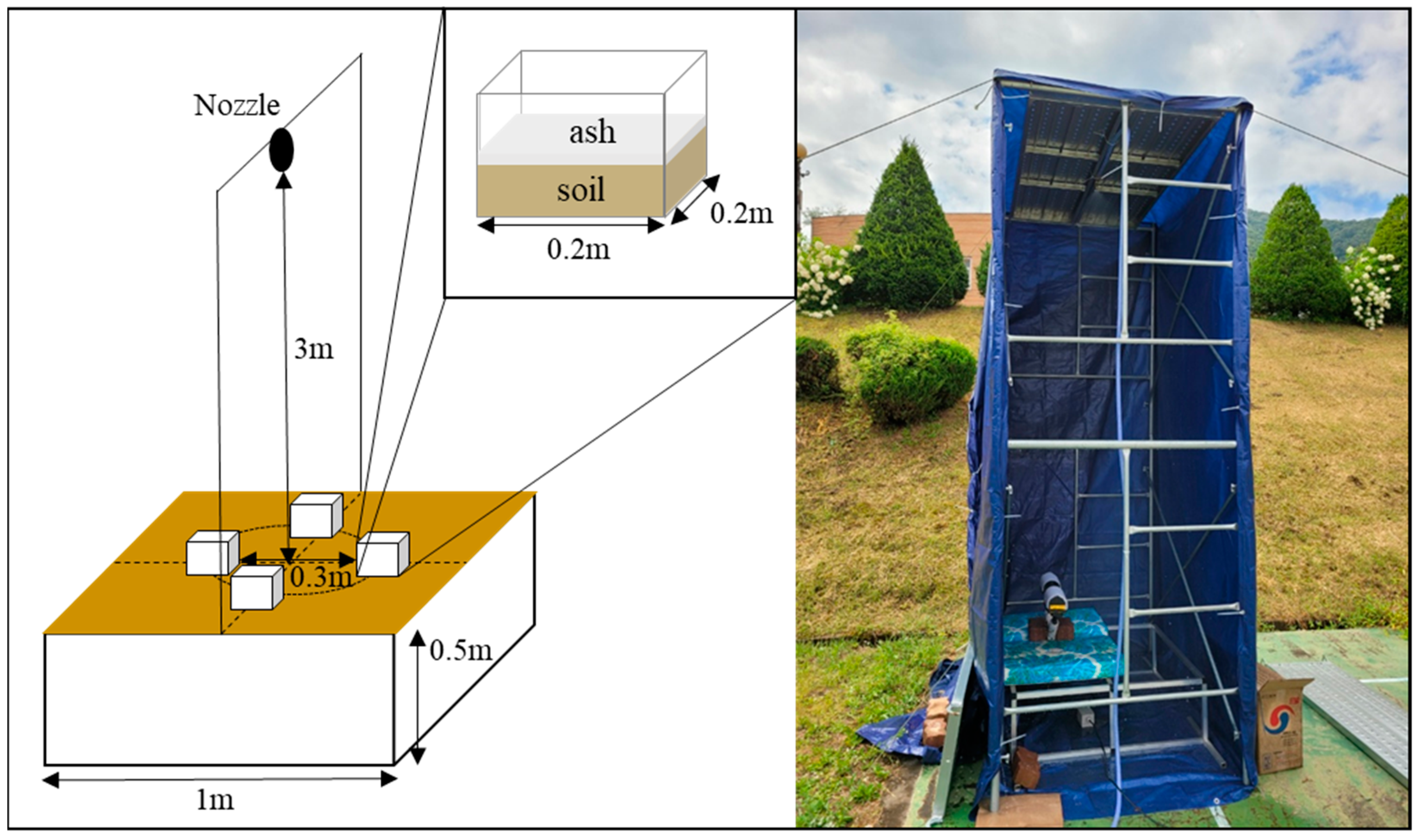
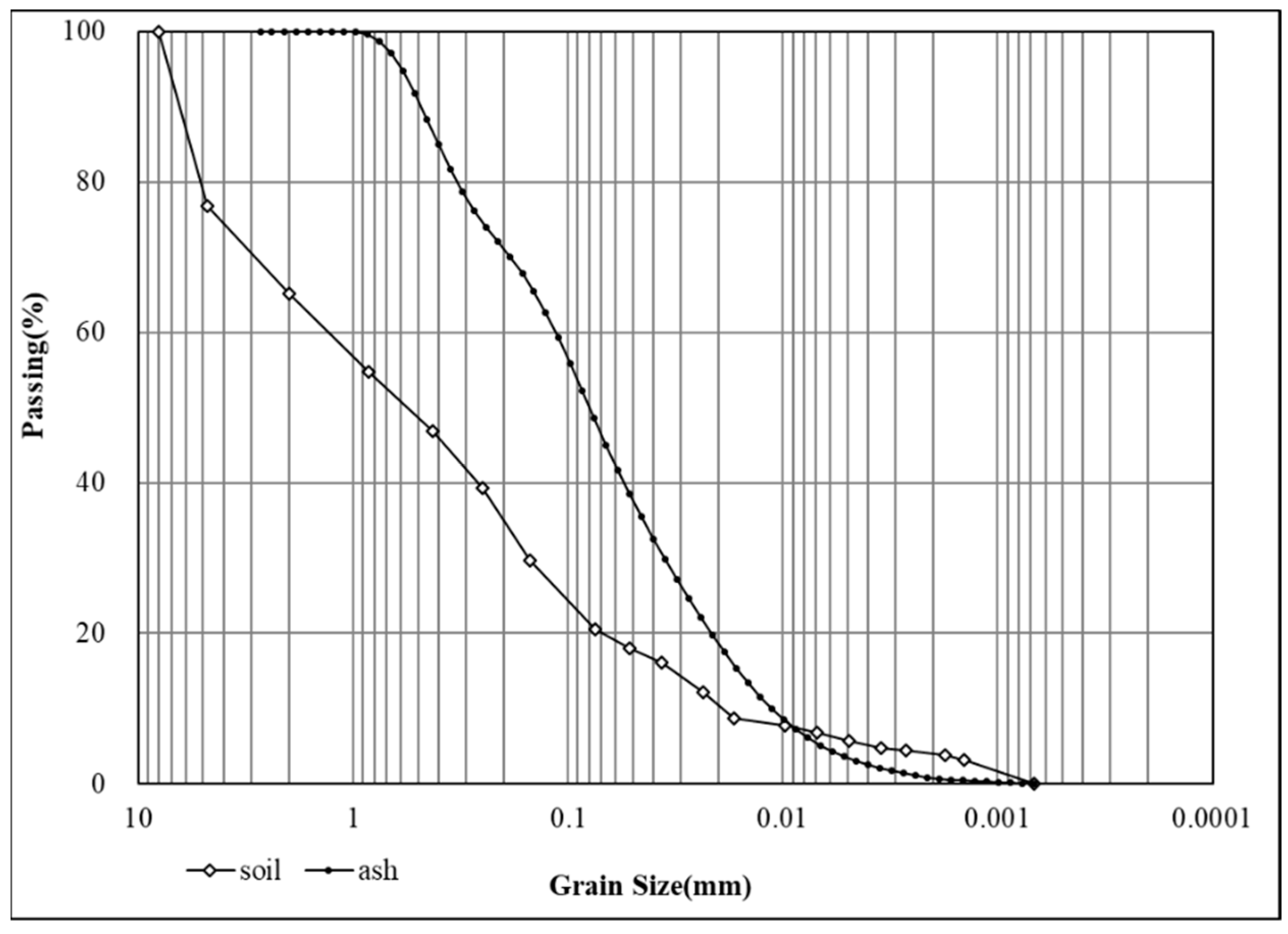
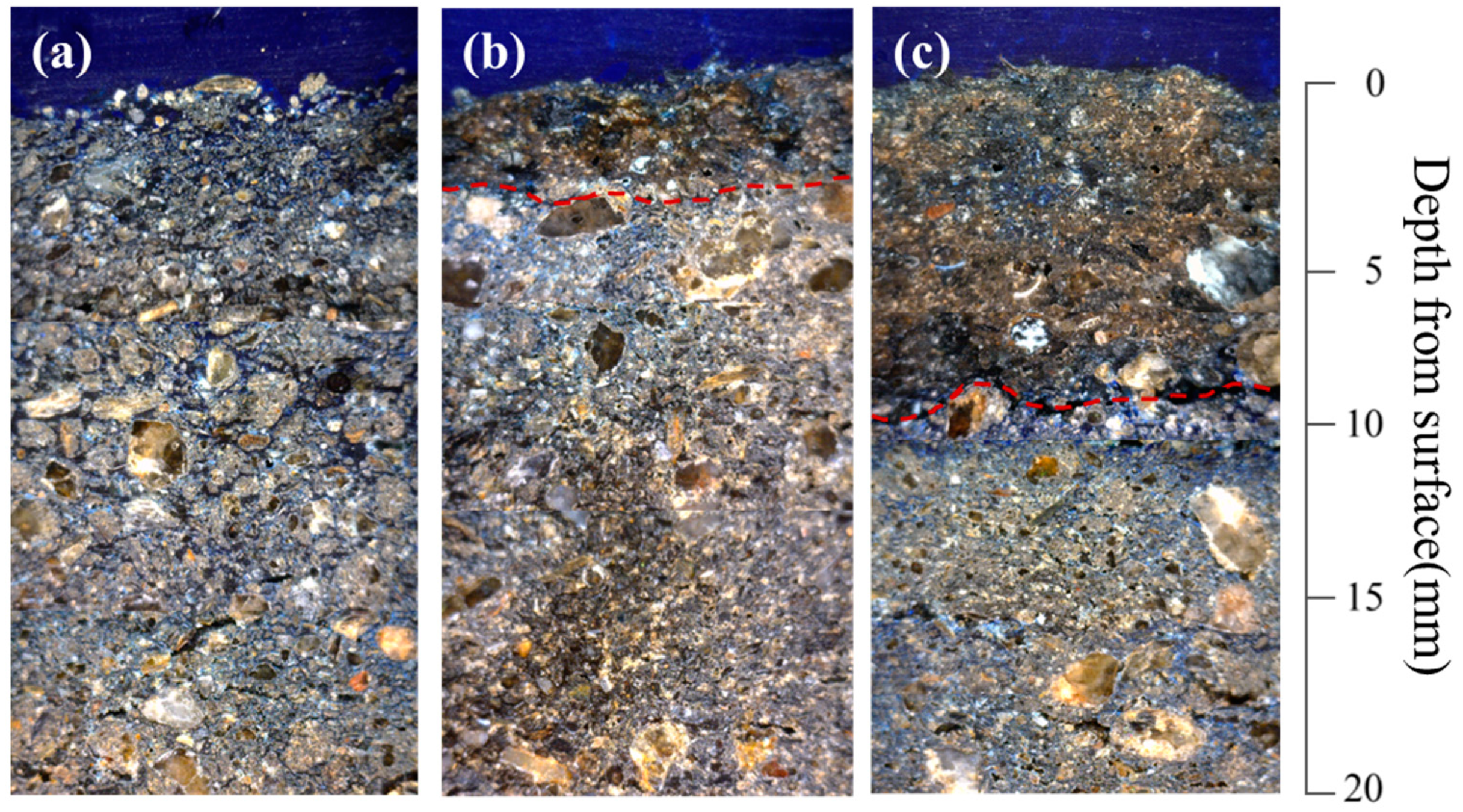
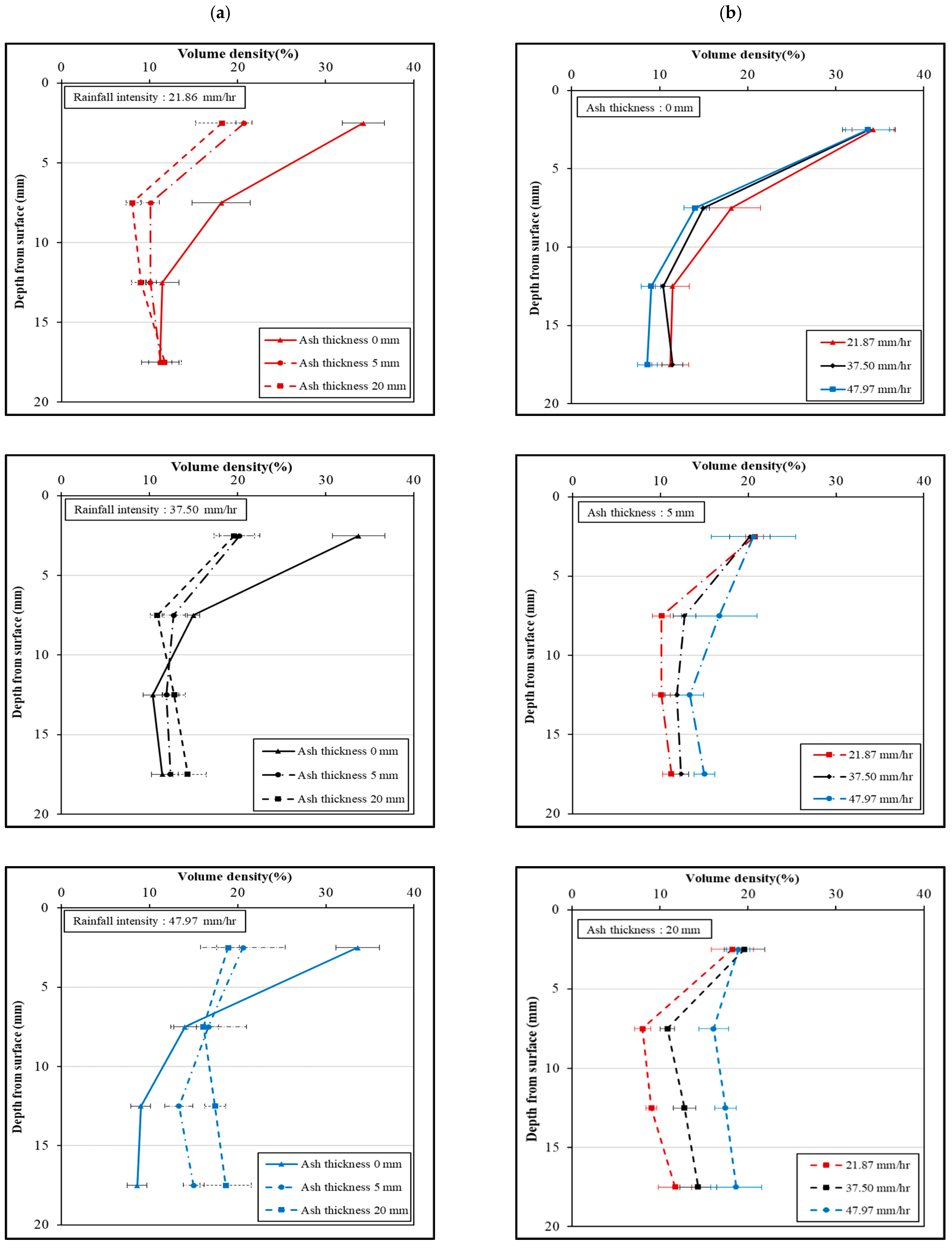
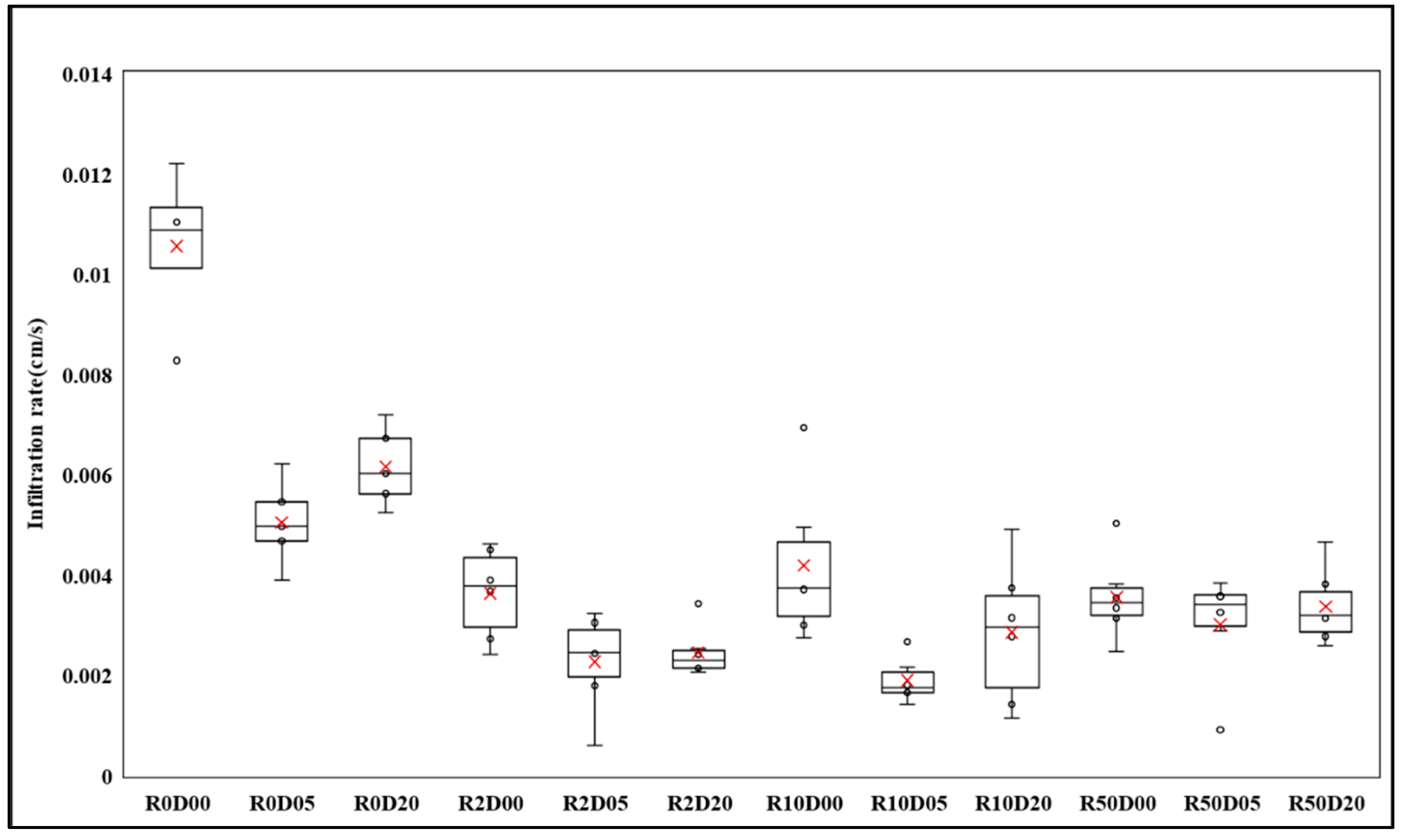
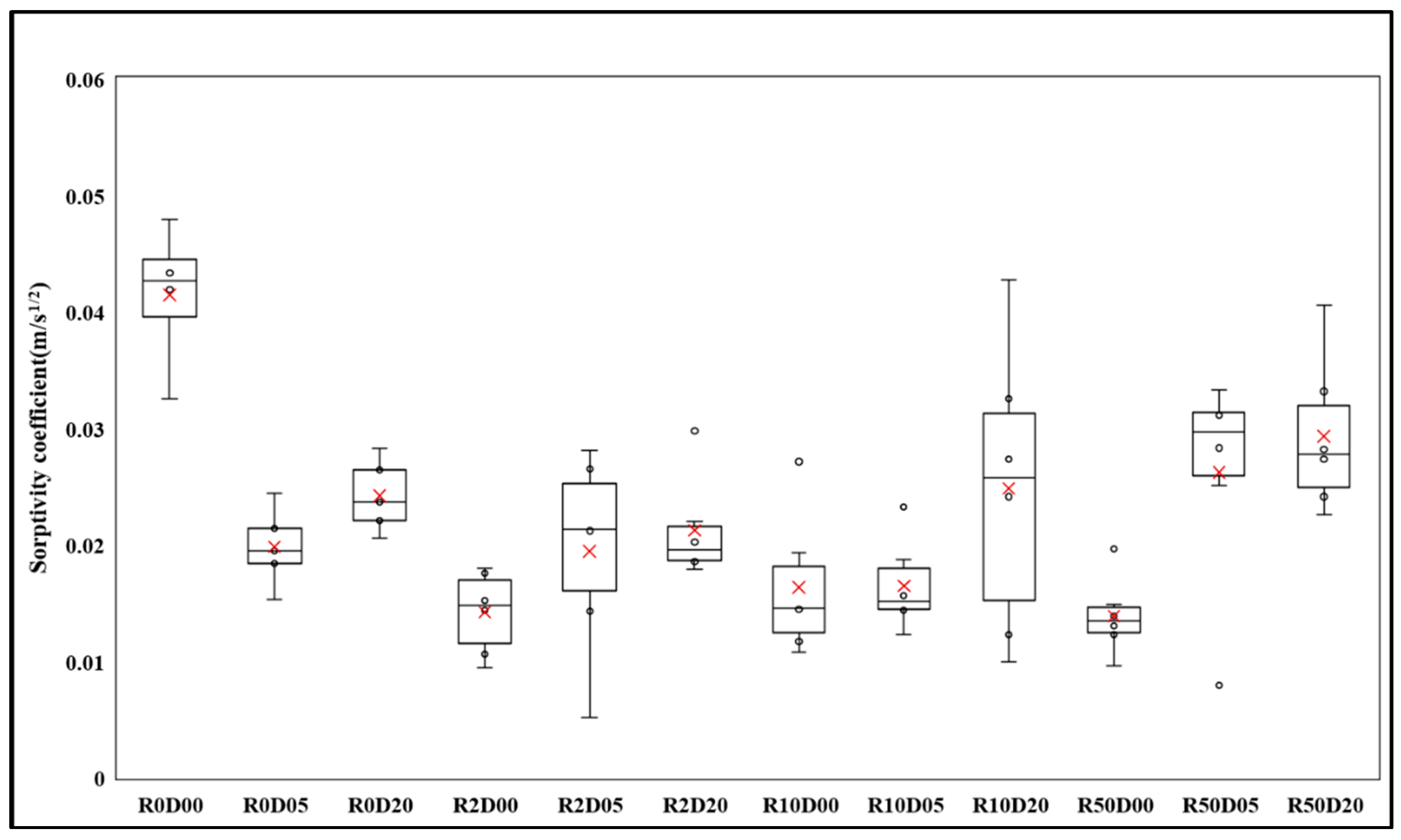
| Experiment | Return Period (Year) | Spray Nozzle | Rainfall Intensity (mm/h) | Kinetic Energy (J/m2/h) | Christiansen’s Uniformity Coefficient | ||
|---|---|---|---|---|---|---|---|
| Diameter (mm) | Discharge (L/min) | Okgye [41] | This Study | ||||
| R02 | 2 | 0.89 | 0.74 | 22.2 | 21.87 ± 9.02 | 35.19 ± 15.86 | 0.91 |
| R10 | 10 | 2.0 | 3.7 | 35.6 | 37.50 ± 7.63 | 83.55 ± 20.47 | 0.95 |
| R50 | 50 | 3.6 | 11.1 | 57.3 | 47.97 ± 8.97 | 134.08 ± 30.52 | 0.98 |
| Soil Property | Particle Size Distribution (%) | Soil Texture | pH | TOC (%) | Bulk Density (g/cm3) | ||
|---|---|---|---|---|---|---|---|
| 2–0.05 mm | 0.05–0.002 mm | <0.002 mm | |||||
| Soil Sample | 79.48 ± 0.41 | 16.68 ± 0.90 | 3.84 ± 0.34 | Loamy sand | 5.28 ± 0.27 | 5.53 ± 1.38 | 1.25 ± 0.10 |
| SM | |||||||
| VolumeDensity (%) | R0 | R2 | R10 | R50 | |||||||
|---|---|---|---|---|---|---|---|---|---|---|---|
| D00 | D00 | D05 | D20 | D00 | D05 | D20 | D00 | D05 | D20 | ||
| Soil Depth (mm) | 0–5 | 56.1 ± 1.3 | 34.3 ± 2.4 | 20.7 ± 0.9 | 18.2 ± 2.4 | 33.7 ± 3.0 | 20.2 ± 2.3 | 19.1 ± 2.3 | 33.6 ± 2.5 | 20.6 ± 4.8 | 18.9 ± 1.3 |
| 5–10 | 38.1 ± 3.1 | 18.1 ± 3.3 | 10.1 ± 1.0 | 8.0 ± 0.9 | 15.0 ± 0.7 | 12.8 ± 1.3 | 10.5 ± 0.8 | 14.0 ± 1.3 | 16.7 ± 4.3 | 16.1 ± 1.7 | |
| 10–15 | 27.7 ± 4.2 | 11.4 ± 1.9 | 10.1 ±0.7 | 9.0 ± 0.6 | 10.4 ± 1.1 | 11.9 ± 1.4 | 12.3 ± 1.3 | 9.0 ± 1.3 | 13.3 ± 1.6 | 17.4 ± 1.2 | |
| 15–20 | 24.4 ± 4.0 | 11.2 ±2.1 | 11.2 ±1.3 | 11.7 ± 1.9 | 11.4 ± 1.2 | 12.4 ± 0.9 | 14.1 ± 2.1 | 8.6 ± 1.1 | 15.0 ± 1.2 | 18.6 ± 2.9 | |
| Experiment | Hydraulic Conductivity (cm/s) | Reduction Rate (%) | Tukey’s HSD | Sorptivity Coefficient (m/s1/2) | Reduction Rate (%) | Tukey’s HSD | |
|---|---|---|---|---|---|---|---|
| R00 | D00 | 0.0104 ± 0.0013 | c | 0.0409 ± 0.0052 | b | ||
| D05 | 0.0059 ± 0.00089 | ab | 0.0231 ± 0.0035 | ab | |||
| D20 | 0.0082 ± 0.0021 | bc | 0.0324 ± 0.0083 | ab | |||
| R02 | D00 | 0.0036 ± 0.0004 | −65.1 | a | 0.0142 ± 0.0014 | −65.3 | a |
| D05 | 0.0023 ± 0.0004 | −61.5 | a | 0.0194 ± 0.0035 | −16.0 | a | |
| D20 | 0.0025 ± 0.0002 | −70.3 | a | 0.0212 ± 0.0018 | −34.6 | a | |
| R10 | D00 | 0.0042 ± 0.0006 | −59.8 | a | 0.0163 ± 0.0025 | −60.1 | a |
| D05 | 0.0019 ± 0.0002 | −67.8 | a | 0.0165 ± 0.0016 | −28.6 | a | |
| D20 | 0.0029 ± 0.0006 | −65.4 | a | 0.0248 ± 0.0051 | −23.5 | ab | |
| R50 | D00 | 0.0036 ± 0.0003 | −65.9 | a | 0.0139 ± 0.0014 | −66.0 | a |
| D05 | 0.0030 ± 0.0004 | −48.7 | a | 0.0262 ± 0.0038 | +13.4 | ab | |
| D20 | 0.0034 ± 0.0003 | −59.2 | a | 0.0293 ± 0.0027 | −9.6 | ab | |
Publisher’s Note: MDPI stays neutral with regard to jurisdictional claims in published maps and institutional affiliations. |
© 2022 by the authors. Licensee MDPI, Basel, Switzerland. This article is an open access article distributed under the terms and conditions of the Creative Commons Attribution (CC BY) license (https://creativecommons.org/licenses/by/4.0/).
Share and Cite
Kim, T.; Lee, J.; Lee, Y.-E.; Im, S. Exploring the Role of Ash on Pore Clogging and Hydraulic Properties of Ash-Covered Soils under Laboratory Experiments. Fire 2022, 5, 99. https://doi.org/10.3390/fire5040099
Kim T, Lee J, Lee Y-E, Im S. Exploring the Role of Ash on Pore Clogging and Hydraulic Properties of Ash-Covered Soils under Laboratory Experiments. Fire. 2022; 5(4):99. https://doi.org/10.3390/fire5040099
Chicago/Turabian StyleKim, Taehyun, Jeman Lee, Ye-Eun Lee, and Sangjun Im. 2022. "Exploring the Role of Ash on Pore Clogging and Hydraulic Properties of Ash-Covered Soils under Laboratory Experiments" Fire 5, no. 4: 99. https://doi.org/10.3390/fire5040099
APA StyleKim, T., Lee, J., Lee, Y.-E., & Im, S. (2022). Exploring the Role of Ash on Pore Clogging and Hydraulic Properties of Ash-Covered Soils under Laboratory Experiments. Fire, 5(4), 99. https://doi.org/10.3390/fire5040099







